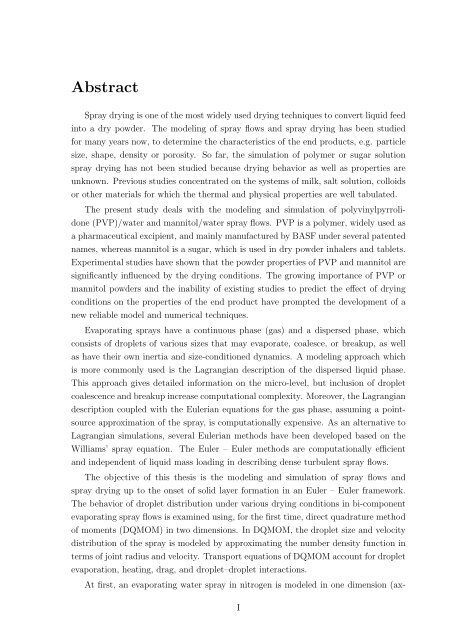INAUGURAL–DISSERTATION zur Erlangung der Doktorwürde der ...
INAUGURAL–DISSERTATION zur Erlangung der Doktorwürde der ...
INAUGURAL–DISSERTATION zur Erlangung der Doktorwürde der ...
You also want an ePaper? Increase the reach of your titles
YUMPU automatically turns print PDFs into web optimized ePapers that Google loves.
Abstract<br />
Spray drying is one of the most widely used drying techniques to convert liquid feed<br />
into a dry pow<strong>der</strong>. The modeling of spray flows and spray drying has been studied<br />
for many years now, to determine the characteristics of the end products, e.g. particle<br />
size, shape, density or porosity. So far, the simulation of polymer or sugar solution<br />
spray drying has not been studied because drying behavior as well as properties are<br />
unknown. Previous studies concentrated on the systems of milk, salt solution, colloids<br />
or other materials for which the thermal and physical properties are well tabulated.<br />
The present study deals with the modeling and simulation of polyvinylpyrrolidone<br />
(PVP)/water and mannitol/water spray flows. PVP is a polymer, widely used as<br />
a pharmaceutical excipient, and mainly manufactured by BASF un<strong>der</strong> several patented<br />
names, whereas mannitol is a sugar, which is used in dry pow<strong>der</strong> inhalers and tablets.<br />
Experimental studies have shown that the pow<strong>der</strong> properties of PVP and mannitol are<br />
significantly influenced by the drying conditions. The growing importance of PVP or<br />
mannitol pow<strong>der</strong>s and the inability of existing studies to predict the effect of drying<br />
conditions on the properties of the end product have prompted the development of a<br />
new reliable model and numerical techniques.<br />
Evaporating sprays have a continuous phase (gas) and a dispersed phase, which<br />
consists of droplets of various sizes that may evaporate, coalesce, or breakup, as well<br />
as have their own inertia and size-conditioned dynamics. A modeling approach which<br />
is more commonly used is the Lagrangian description of the dispersed liquid phase.<br />
This approach gives detailed information on the micro-level, but inclusion of droplet<br />
coalescence and breakup increase computational complexity. Moreover, the Lagrangian<br />
description coupled with the Eulerian equations for the gas phase, assuming a pointsource<br />
approximation of the spray, is computationally expensive. As an alternative to<br />
Lagrangian simulations, several Eulerian methods have been developed based on the<br />
Williams’ spray equation. The Euler – Euler methods are computationally efficient<br />
and independent of liquid mass loading in describing dense turbulent spray flows.<br />
The objective of this thesis is the modeling and simulation of spray flows and<br />
spray drying up to the onset of solid layer formation in an Euler – Euler framework.<br />
The behavior of droplet distribution un<strong>der</strong> various drying conditions in bi-component<br />
evaporating spray flows is examined using, for the first time, direct quadrature method<br />
of moments (DQMOM) in two dimensions. In DQMOM, the droplet size and velocity<br />
distribution of the spray is modeled by approximating the number density function in<br />
terms of joint radius and velocity. Transport equations of DQMOM account for droplet<br />
evaporation, heating, drag, and droplet–droplet interactions.<br />
At first, an evaporating water spray in nitrogen is modeled in one dimension (ax-<br />
I













